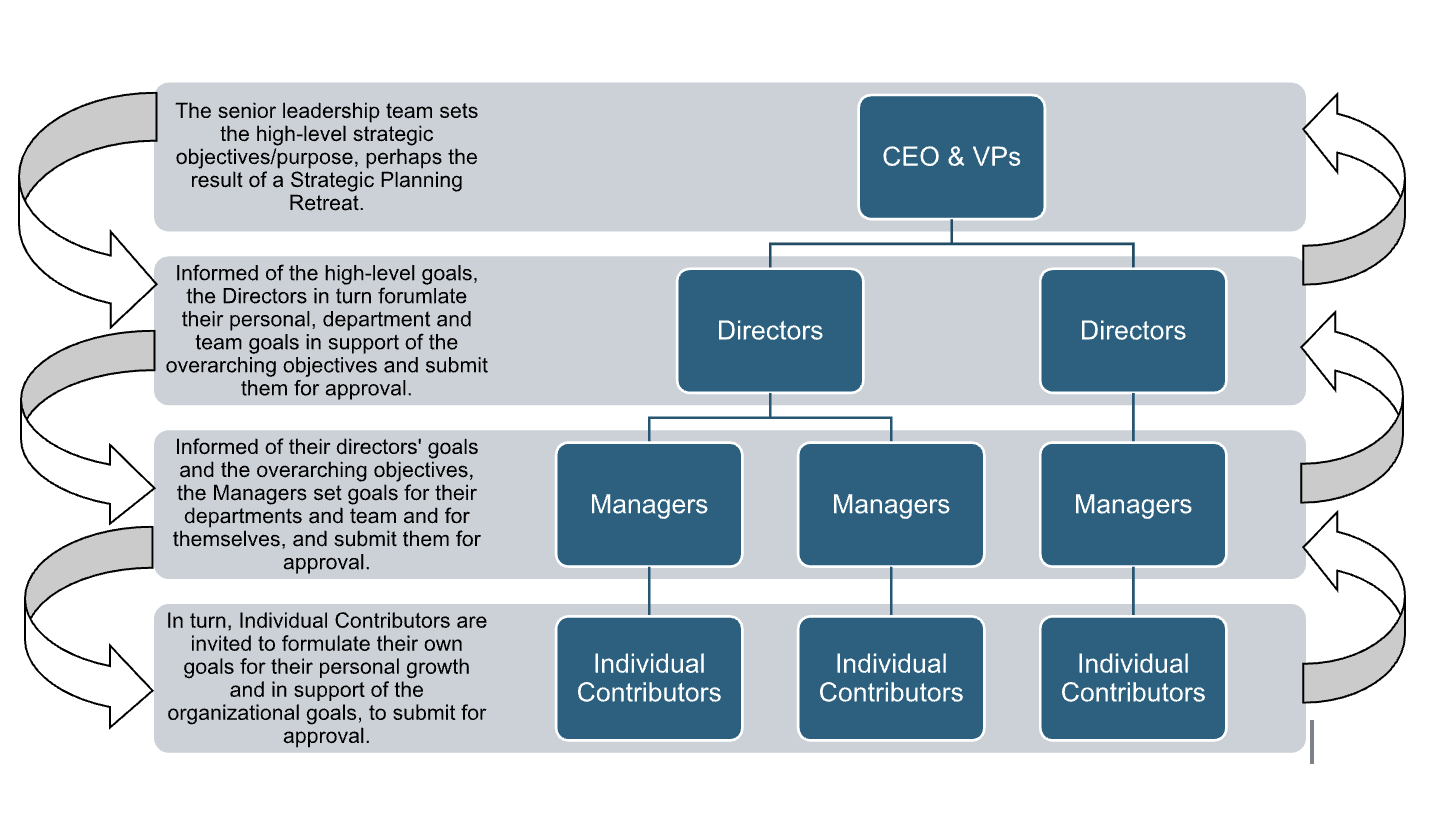
Ashli Komaryk, Associate Consultant, Chemistry Consulting Group
Chemistry Consulting Group is a full-service HR consulting firm servicing clients across Canada and throughout the US providing HR Consulting, Recruitment Services and Leadership Development to private and public sector organizations as well as non-profit entities. Chemistry takes time to understand your business needs and provide support in the areas where you need it, so you can continue to do what you do best – and they handle the rest. The Leadership Development Programs at Chemistry are customized and delivered by Associate Consultant, Ashli Komaryk, Certified Organizational Coach.
If you don’t know where you’re going, how will you ever know when you get there? Setting goals gives us a destination or target to work towards. But how do we pick those goals? Who picks them? Why those goals and not different ones? What about timelines? How can we make sure individual goals align with the high-level strategic goals of the organization?
So many questions! Putting in the effort to get the answers that are right for your organization can unleash the full potential of your team, build employee engagement (and retention) and fuel intrinsic and extrinsic motivation, propelling your organization to greater success than you could have ever imagined!
Get S.M.A.R.T. with your Goals!
Let’s start with a powerful tool. Leveraging the S.M.A.R.T. goal-setting model (Specific, Measurable, Achievable, Relevant, Time-bound) can provide a dynamic framework for setting goals and also support performance management. Here’s how it works.
Having Specific goals is essential so employees know exactly what is expected of them and what constitutes “success.” You don’t want to be pouring 100% of your effort while going in the wrong direction!
Measurable goals allow employees (and their leaders) to monitor progress, offer/receive support if needed, or course-correct in a timely manner if things are going in the wrong direction. A measurable goal also enables employees and managers to acknowledge (and celebrate) the concrete evidence of success.
Achievable goals ensure that the targets are challenging enough to provide incentive and stimulation to achieve them (more on the Flow State below) without being unrealistic or plainly impossible to attain. Relevant goals show employees how their individual goals support the organization's over-arching mission and strategic purpose, fuelling a deeper sense of purpose.
Time-bound goals provide clarity on when employees need to accelerate or intensify their efforts to reach their goals. Without deadlines, there is never a need for urgency.
Aligning Individual Goals with Organizational Goals
Now that we’ve considered a model for setting goals, how do we make sure the SMART goals your team has come up with are the most appropriate goals for your organization?
Investing time in strategic planning is a good place to start. It’s like a ship’s captain setting the course for the next destination and then communicating that plan to the entire crew. A North Atlantic crossing and a gentle sail through the Caribbean are two very different types of journey. Knowing what lies ahead and how their specific job contributes to the voyage toward the next destination allows each crew member to make adjustments and calibrate their efforts and contributions to best support the overall objective.
Many organizations use a cascading approach to align organizational goals with individual goals. Here’s a simple graphic rendition as one example of how to use this cascading approach. Feel free to adjust and adapt it to suit your organization’s structure and size.

Performance Management to Optimize Outcomes
Setting appropriate SMART goals in alignment with the organization’s high-level strategic objectives is a powerful first step. Leaders now have a great tool, especially if they bring a coach approach to their leadership style with periodic and supportive check-ins, potentially replacing the dreaded (insufficient and highly ineffective) annual performance review. The goals form a foundation for clear communication, opportunities for employees to surface challenges and for leaders to identify where they can provide support, training or encouragement and update employees on any changes that may impact their progress. This open dialogue builds trust and contributes to building a supportive and collaborative culture.
Motivation and “Flow” for Peak Performance in Goal Achievement
Magic happens when great leaders truly understand their team members and incorporate their knowledge of what motivates each one of them into their leadership approach. While personality assessments like DiSC provide leaders with an excellent tool and conversation-starter to understand the motivators and the stressors that are unique to each member of their team, open, honest and direct dialogue is also an excellent approach to understanding what people want and need.
Daniel Pink, in his insightful book “Drive,” explored the difference between intrinsic and extrinsic motivators. He cited research demonstrating the powerful effectiveness of intrinsic motivators (Autonomy, Mastery, Purpose) when it comes to problem-solving work or creative tasks. Which of those three motivators (or a combination thereof) are integrated in setting goals for your team?
You’ve probably heard the expression “being in flow” or “being in a state of flow.” Mihaly Csikszentmihalyi, author of “Flow: The Psychology of Optimal Experience,” stated that “The best moments in our lives are not the passive, receptive, relaxing times… The best moments usually occur if a person’s body or mind is stretched to its limits in a voluntary effort to accomplish something difficult and worthwhile.”
Mr. Csikszentmihalyi described flow as that state when we’re laser-focused, when we lose the concept of time, and when the ideal balance of the challenge/skill ratio energizes us. How amazing would it be if our jobs provided us with that feeling every day?
The good news is we can certainly work toward that. It means setting goals and targets that your team members have the skills (or potential) to achieve but that also require them to push themselves or stretch to get there. Take a look below at the graph from Mr. Csikszentmihalyi’s research to see how the state of Flow is the sweet spot we’re aiming for and ask yourself into which segment your team’s current goals fall.
Source: Mihaly Csikszentmihalyi.
Putting it all together
Leaders often overlook the potential that lies in proactively engaging your team in goal-setting. Yet it’s an extremely powerful process to achieve greater employee success which will lead to success for your team and your organization. As a leader of any team, regardless of its size or sector, you have the ability to increase your team’s performance and also their level of satisfaction and engagement. This naturally will result in greater overall success for the organization as a whole. Here are key steps to consider:
- Know your team – understand how each member is motivated. What lights the fire within each one? Consider whether their targets are tapping into those specific motivational forces.
- Ensure you are setting SMART goals that sufficiently challenge your team. You want to ensure all five of those aspects are addressed for the most effective and clear path toward success while you try to keep your team members in their own “flow state.”
- Verify that individual goals are directly and demonstrably in support of the high-level organizational goals – ensure each employee understands how their specific contribution fits into your organization’s purpose.
- Bring a coach approach to your leadership style with regular check-ins on those SMART goals to partner with your team members as they strive to reach their targets.
Contact the team at Chemistry Consulting Group if you’d like to explore a facilitated strategic goal-setting workshop for your team or leadership support to manage this process. Goal-setting and facilitating our clients’ success are some of our favourite things!
References
- Csikszentmihalyi, M. (2008). Flow: The Psychology of Optimal Experience. 1st Harper Perennial Modern Classics ed. New York, Harper Perennial.
- Pink, D. H. (2011) Drive. Canongate Books







